Autobiographical Design for Emotional Durability through Digital Transformable Fashion and Textiles
Abstract
:1. Introduction
2. Literature Review
2.1. The Emotionally Durable Design
2.2. Digital Transformable Fashion and Textiles
2.3. Correlating Digital Transformable Fashion and Textiles with Emotional Durability
2.3.1. Design for Versatility and Adaptability
2.3.2. Design for Perceived Quality
2.3.3. Design for Biomorphic Forms
2.3.4. Design for Aesthetics
3. Methodology
3.1. Craft Thinking and Making as a Tool in Research through Design
3.2. Autobiographical Soma Design from the First-Person Perspective
4. Case Study 1: Pneum-Muscle—A Remote-Control Transformable Garment
4.1. The Design Concept
4.2. The Design Process
4.2.1. Design for Versatility
4.2.2. Design for Perceived Quality
4.2.3. Design for Affective Capacity
- The designer focused on internal feelings and extended the feelings through material expression. When the designer evaluated the prototype on the body, she noted, ‘I can feel my body extended and connected to the surroundings. I am encouraged to open my heart and expand my mind; I need more inflatables stretching to both ends of my chest……and the two twisted inflatables should intersect at my oblique muscles……’. Being attentive to the subtle and ongoing feelings generated from material experience, the designer improved her ability to sense the balance, scale, and movement of the materials through the body’s muscle and skeletal systems. Collages and sketches were used to develop structures that mimic the extended muscles according to bodily feedback to grasp intuition and sensations.
- Material properties were examined by differentiating haptic sensations elicited from various body parts. During the material manipulation and worn test, the tactile sensations facilitated the designer’s understanding of the possibilities and constraints fabrics may apply [58]. The designer noted, ‘I can feel the inflatables at my front holding me tightly. The constantly pumped air forms a powerful energy flow permeating my skin throughout my body. I feel supported and cared for when I stretch my muscles and follow the energy flow. Even when the wings-like structures on my back expand, I can feel the accumulation of air current at the back even though I cannot see it. The haptic feedback also makes me more aware of my muscles’ contraction, flexion, and extension, which makes me know better about myself. However, I feel that the forces produced by the inflatables are average and lack variations to some extent. I need more pressure at the back while the pressure at the shoulder can be reduced.’ The subtleties in tactile sensations helped the designer to make better design choices. By arranging different sizes and lengths of tubes on various parts of the body, various intensities of haptic feedback can be offered to improve the wearing experience.
- Sculptural thinking was incorporated during material manipulation. The designer moved backwards and forward between the three-dimensional work to foster experimental play with proportions, volume, shape, and transformation. By navigating the space from different distances and perspectives, the designer understood where the inflatables started and ended, how they evolved into pop-up structures, and how they intertwined with each other to span across the body. Such findings can benefit the pattern-cutting and tracing of transformation trajectories.
- Ambiguity was introduced to pattern cutting. After iterative prototyping, the ideas of space and structure were recorded and traced by patterns to reflect how the prototype engaged with the interactive space around the body and environment (Figure 8). Normally, patterns of garments have rather fixed areas and clear structure lines that differentiates various parts of the body for functionality and fit. However, in this project, when the designer mapped the geometry and energy flow of the textile system, traditional rules of draping and pattern cutting were broken. Without presumed pragmatic demands, the structures and patterns evolved according to the designer’s constant reflections of extended space beyond the body. The concept of spatial and functional ambiguity in architectural design was borrowed to disrupt the predetermined size, area, and spatial relationship [59] of garment structures. In particular, we developed the following concepts: connecting interior space with the exterior, designing multifunctional spaces, creating alternative entries, and designing ambiguous spaces [59]. These ideas were adapted into both the pattern-cutting and prototyping processes as unorthodox methods. As a result, different parts, such as the collar or sleeves, were not draped deliberately to be collar-like or sleeve-like, but the fluid space around the body naturally flowed, gathered, or bulged to form the shape and function. The form was not mapped by predetermined division lines but emerged through material engagement such as stitching, cutting, combinations and juxtapositions [60]. Various pieces of fabric were joined, reversed, and intertwined to create more possibilities and spatial affordances.
4.2.4. Design for Aesthetics
- The appealing experience was constructed by involving the wearer in the playful assemblage process. During the material design, we did not obey the rules of the conventional fashion design process, such as pragmatic functional design and perfect fit and tailoring. Instead, we embraced art-based methods such as sculptural thinking to deconstruct and diminish the boundaries between the skin and the garment. Through haptic stimulation, the energy flow of the Pneum-Muscle leaks from materials to the flesh [62] and triggers various sensations to elicit intra-actions in the wearer’s inner psyche and interaction with the external world to form a whole.
- Softness, fluidity, and ambiguity were introduced to technological wearables. In the conventional sense, digital wearables are mechanical, cold, and emotionless. In Pneum-Muscle, we expressed embodiment and sensations through volume and space to achieve a natural, lifelike appearance. The inflatables expand and contract to form elegant flows, curves, and twists, mimicking inner bodily sensations and creating muscle-like movements. Furthermore, we valued the uncertainties and ambiguities created by the fluid structures, which can arouse people’s curiosity and desire to touch and wear Pneum-Muscle.
5. Case Study 2: E-Coral—A Touch-Sensitive Shape-Changing Textile Installation
5.1. The Design Concept
5.2. The Design Process
5.3. Embracing Lifelikeness to Improve Perceived Quality
5.4. Creating the Transformation Pattern of E-Coral
5.5. Touch as a Tool for Material Exploration
5.6. Touch as a Medium to Trigger Emotions and Reflections
- The movement of the E-coral was associated with mindful breathing. The designer commented, ‘The lifelike movements are energetic and rhythmic, just like the breathing of coral. It can make me aware of my breathing and calm me down.’ Through the interaction, we found that the movement of the E-coral has the potential to guide the user’s mindful breathing and self-awareness. Future studies can explore how breathing movement influences people’s feelings.
- The material behaviour was perceived as anthropomorphic. As the designer said, ‘Its adaptation to my behaviours seems to mimic them and make me happy like an empathetic person’. The emotional abilities of E-coral might be associated with its anthropomorphic behaviours. The influence of mimicking behaviours of artefacts on users’ feelings and emotions still needs to be explored in future studies.
- The interactive experience was perceived as spiritual. The designer suggested, ‘The black and white colours and abstract movement reminds me of the aesthetics of Taiji and Taoism, and the tactile interaction is just like a spiritual experience for me.’ In terms of aesthetic experience, further research can be developed to see if oriental philosophy and cultural connotations can be incorporated into E-coral as spiritual enlightenment.
6. Discussions and Implications for Theory and Design Practice
6.1. Implications for Autobiographical Soma Design
- The somatic response resulting from emotional changes should be incorporated into the design response. Apart from qualitative self-investigation, more design methods need to be proposed to generate and analyse the somatic data of emotions. Designers should value the subjective feelings that emerge during the design journey and translate them into design languages. More artistic expressions and crafts can be developed to map the patterns of subjective feelings. In iterative design process, designers need to constantly compare somatic and emotional responses towards different design variables (e.g., form, shape, colour) to enhance material experience.
- Through interaction with artefacts and the environment, designers should pay attention to sensations and feelings inside the body when they encounter external stimuli. Furthermore, intra-action can be externalised and embodied through design tools to form the parameters of the interaction. In future studies, designers will need to investigate how certain material behaviours elicit corresponding psychological changes, and the best approach to realising internal self-attunement through digital material interaction remains unexplored.
6.2. Implications for Emotional Durable-Driven Engagements in Fashion and Interaction Design
- In the iterative design process, it is beneficial to raise the user’s awareness of emotion changes and grasp feelings using qualitative and quantitative tools to create a situated design response. According to the designer’s emotional experience in this study, we found that the actuated feedback of the product can induce users’ meditation, which is similar to Höök et al.’s [39] findings that the changing stimuli of sensory feedback can shift the user’s attention, keep their mind focused, and make them aware of the ongoing feelings. A future study can explore the influence of sensory actuation on somatic awareness, mindfulness, or emotion regulation.
- To develop the fashion-tech pedagogy, more interaction design tools can be introduced to fashion innovation to enrich construction methods. This study incorporated pneumatic systems into fashion prototyping and aesthetic expression. In future research, more systematic design strategies concerning fashionable technology should be built from the fashion designer’s perspective. A similar suggestion is made by Seyed [69], who argues that it is worth exploring the field of fashion and merging it with HCI to contribute to a broader research community.
- Our case study manifested that tactile or haptic interaction is associated with the therapeutic experience and boosted mood. Pneum-Muscle can open the wearer’s mind and elicit comfortable sensations. At the same time, E-coral is regarded as empathetic and caring and helps induce calm. This reflection echoes the findings of Meijer et al. [70], which suggest that people’s need for affective touch increases during the COVID-19 pandemic. We believe there is a need to further the research on tactile and haptic interaction to satisfy people’s psychological and emotional needs.
6.3. Implications for Material Transformation Design
- This study mainly combined hand-sewing techniques into transformation design to create a quick response. However, digital manufacturing, such as digital embroidery and machine sewing, can be explored in the future to test digital constructions’ potential for transformable fashion design.
- Despite material properties, immaterial dimensions of transformation need to be explored. In this study, we used material transformation’s emotional and aesthetic perspectives to afford a more interactive and affective system. Understanding the relationship between the material experience and people’s perceptions is the key to designing emotionally durable interactions. In future research, methods from psychology can be incorporated into the design framework to assess the psychological effect of material transformation.
7. Conclusions
8. Limitations and Future Work
Author Contributions
Funding
Institutional Review Board Statement
Informed Consent Statement
Data Availability Statement
Acknowledgments
Conflicts of Interest
References
- Guldager, S. Irreplaceable Luxury Garments: Creating Emotional Engagement. In Handbook of Sustainable Luxury Textiles and Fashion; Gardetti, M.A., Muthu, S.S., Eds.; Environmental Footprints and Eco-design of Products and Processes; Springer: Singapore, 2016; pp. 73–97. ISBN 978-981-287-741-3. [Google Scholar]
- Cao, H.; Chang, R.; Kallal, J.; Manalo, G.; McCord, J.; Shaw, J.; Starner, H. Adaptable Apparel: A Sustainable Design Solution for Excess Apparel Consumption Problem. J. Fash. Mark. Manag. 2014, 18, 52–69. [Google Scholar] [CrossRef]
- Haines-Gadd, M.; Chapman, J.; Lloyd, P.; Mason, J.; Aliakseyeu, D. Emotional Durability Design Nine—A Tool for Product Longevity. Sustainability 2018, 10, 1948. [Google Scholar] [CrossRef] [Green Version]
- Fletcher, K. Durability, Fashion, Sustainability: The Processes and Practices of Use. Fash. Pract. 2012, 4, 221–238. [Google Scholar] [CrossRef]
- Alsharif, A.H.; Salleh, N.Z.M.; Al-Zahrani, S.A.; Khraiwish, A. Consumer Behaviour to Be Considered in Advertising: A Systematic Analysis and Future Agenda. Behav. Sci. 2022, 12, 472. [Google Scholar] [CrossRef] [PubMed]
- Barile, N.; Sugiyama, S. Wearing Data: From McLuhan’s “Extended Skin” to the Integration Between Wearable Technologies and a New Algorithmic Sensibility. Fash. Theory 2020, 24, 211–227. [Google Scholar] [CrossRef]
- Loke, L.; Schiphorst, T. The Somatic Turn in Human-Computer Interaction. Interactions 2018, 25, 54–5863. [Google Scholar] [CrossRef]
- Alsharif, A.H.; Md Salleh, N.Z.; Khraiwish, A. Biomedical Technology in Studying Consumers’ Subconscious Behavior. Int. J. Online Biomed. Eng. 2022, 18, 98–114. [Google Scholar] [CrossRef]
- Foo, E.W.; Dunne, L.E.; Holschuh, B. User Expectations and Mental Models for Communicating Emotions through Compressive & Warm Affective Garment Actuation. Proc. ACM Interact. Mob. Wearable Ubiquitous Technol. 2021, 5, 1–25. [Google Scholar] [CrossRef]
- Wang, W.; Nagai, Y.; Yuan, F.; Maekawa, M. Interactive Technology Embedded in Fashion Emotional Design: Case Study on Interactive Clothing for Couples. Int. J. Cloth. Sci. Technol. 2018, 30, 302–319. [Google Scholar] [CrossRef]
- Alsharif, A.H.; Md Salleh, N.Z.; Baharun, R.; Rami Hashem E, A. Neuromarketing Research in the Last Five Years: A Bibliometric Analysis. Cogent Bus. Manag. 2021, 8, 1978620. [Google Scholar] [CrossRef]
- Chapman, J. Design for (Emotional) Durability. Des. Issues 2009, 25, 29–35. [Google Scholar] [CrossRef] [Green Version]
- Aakko, M.; Niinimäki, K. Quality Matters: Reviewing the Connections between Perceived Quality and Clothing Use Time. J. Fash. Mark. Manag. Int. J. 2021, 26, 107–125. [Google Scholar] [CrossRef]
- van Tienhoven, M.A.; Smelik, A. The Affect of Fashion: An Exploration of Affective Method. Crit. Stud. Fash. Beauty 2021, 12, 163–183. [Google Scholar] [CrossRef]
- Wolfs, E.L.M. Biophilic Design and Bio-Collaboration. Arch. Des. Res. 2015, 113, 71. [Google Scholar] [CrossRef] [Green Version]
- Chapman, J.A. Emotionally Durable Design: Sustaining Relationships between Users and Domestic Electronic Products; University of Brighton: Brighton, UK, 2008; p. 171. [Google Scholar]
- Seyed, T.; Devine, J.; Finney, J.; Moskal, M.; de Halleux, P.; Hodges, S.; Ball, T.; Roseway, A. Rethinking the Runway: Using Avant-Garde Fashion to Design a System for Wearables. In Proceedings of the 2021 CHI Conference on Human Factors in Computing Systems, Yokohama, Japan, 8–13 May 2021; Association for Computing Machinery: New York, NY, USA, 2021; pp. 1–15. [Google Scholar]
- Fletcher, K. Exploring Demand Reduction through Design, Durability and ‘Usership’ of Fashion Clothes. Phil. Trans. R. Soc. A 2017, 375, 20160366. [Google Scholar] [CrossRef] [Green Version]
- Neto, A.; Ferreira, J. From Wearing off to Wearing on: The Meanders of Wearer–Clothing Relationships. Sustainability 2020, 12, 7264. [Google Scholar] [CrossRef]
- Bansal, M. Emotionally Durable Fashion. Available online: https://static1.squarespace.com/static/5a272e5b4c326d40ad1db324/t/6014510f7c256767fa86e998/1611944207483/Mihika+Bansal+-+Emotionally+Durable+Fashion.pdf (accessed on 24 February 2023).
- Alsharif, A.H.; Salleh, N.Z.M.; Baharun, R.; Hashem E, A.R.; Mansor, A.A.; Ali, J.; Abbas, A.F. Neuroimaging Techniques in Advertising Research: Main Applications, Development, and Brain Regions and Processes. Sustainability 2021, 13, 6488. [Google Scholar] [CrossRef]
- Karana, E.; Pedgley, O.; Rognoli, V. On Materials Experience. Des. Issues 2015, 31, 16–27. [Google Scholar] [CrossRef] [Green Version]
- Rahman, O.; Gong, M. Sustainable Practices and Transformable Fashion Design—Chinese Professional and Consumer Perspectives. International J. Fash. Des. Technol. Educ. 2016, 9, 233–247. [Google Scholar] [CrossRef]
- Stylios, G.K. Engineering Textile and Clothing Aesthetics Using Shape Changing Materials. In Intelligent Textiles and Clothing; Elsevier: Amsterdam, The Netherlands, 2006; pp. 165–189. ISBN 978-1-84569-005-2. [Google Scholar]
- Brancart, S.; De Laet, L.; De Temmerman, N. Deployable Textile Hybrid Structures: Design and Modelling of Kinetic Membrane-Restrained Bending-Active Structures. Procedia Eng. 2016, 155, 195–204. [Google Scholar] [CrossRef] [Green Version]
- Belforte, G.; Eula, G.; Ivanov, A.; Raparelli, T.; Sirolli, S. Presentation of Textile Pneumatic Muscle Prototypes Applied in an Upper Limb Active Suit Experimental Model. J. Text. Inst. 2018, 109, 757–766. [Google Scholar] [CrossRef]
- Rasmussen, M.K.; Pedersen, E.W.; Petersen, M.G.; Hornbæk, K. Shape-Changing Interfaces: A Review of the Design Space and Open Research Questions. In Proceedings of the SIGCHI Conference on Human Factors in Computing Systems, Austin, TX, USA, 5–10 May 2012; ACM: Austin, TX, USA, 2012; pp. 735–744. [Google Scholar]
- Kono, T.; Watanabe, K. Filum: A Sewing Technique to Alter Textile Shapes. In Proceedings of the Adjunct Publication of the 30th Annual ACM Symposium on User Interface Software and Technology, Québec City, QC, Canada, 20 October 2017; ACM: Québec City, QC, Canada, 2017; pp. 39–41. [Google Scholar]
- Nabil, S.; Kučera, J.; Karastathi, N.; Kirk, D.S.; Wright, P. Seamless Seams: Crafting Techniques for Embedding Fabrics with Interactive Actuation. In Proceedings of the 2019 on Designing Interactive Systems Conference, San Diego, CA, USA, 18 June 2019; ACM: San Diego, CA, USA, 2019; pp. 987–999. [Google Scholar]
- Budak, E.P.; Zirhli, O.; Stokes, A.A.; Akbulut, O. The Breathing Wall (BRALL)—Triggering Life (in)Animate Surfaces. Leonardo 2016, 49, 162–163. [Google Scholar] [CrossRef]
- Jørgensen, J.; Bojesen, K.B.; Jochum, E. Is a Soft Robot More “Natural”? Exploring the Perception of Soft Robotics in Human–Robot Interaction. Int. J. Soc. Robot. 2022, 14, 95–113. [Google Scholar] [CrossRef]
- Ahlquist, S.; McGee, W.; Sharmin, S. Actuated Architectures Through Wale- and Course-Wise Tubular Knit-Constrained Pneumatic Systems. In Proceedings of the 7th Annual Conference of the Association for Computer Aided Design in Architecture (ACADIA), Cambridge, MA, USA, 2–4 November 2017; p. 14. [Google Scholar]
- Melnyk, V. Sewing Pneumatic Textures. Available online: http://papers.cumincad.org/data/works/att/caadria2020_129.pdf (accessed on 24 February 2023).
- Bertola, P.; Teunissen, J. Fashion 4.0. Innovating Fashion Industry through Digital Transformation. RJTA 2018, 22, 352–369. [Google Scholar] [CrossRef]
- Koo, H.S.; Dunne, L.; Bye, E. Design Functions in Transformable Garments for Sustainability. Int. J. Fash. Des. Technol. Educ. 2014, 7, 10–20. [Google Scholar] [CrossRef]
- Gong, M. Sustainable Fashion Design: Transformable Garments for Versatility and Longevity. Master’s Thesis, Ryerson University, Toronto, ON, Canada, 2014; 83p. [Google Scholar]
- Gu, P.; Hashemian, M.; Nee, A.Y.C. Adaptable Design. CIRP Ann. 2004, 53, 539–557. [Google Scholar] [CrossRef]
- Stylidis, K.; Wickman, C.; Söderberg, R. Perceived Quality of Products: A Framework and Attributes Ranking Method. J. Eng. Des. 2020, 31, 37–67. [Google Scholar] [CrossRef] [Green Version]
- Höök, K.; Jonsson, M.P.; Ståhl, A.; Mercurio, J. Somaesthetic Appreciation Design. In Proceedings of the 2016 CHI Conference on Human Factors in Computing Systems, San Jose, CA, USA, 7–12 May 2016; ACM: San Jose, CA, USA, 2016; pp. 3131–3142. [Google Scholar]
- Tsaknaki, V. The Breathing Wings: An Autobiographical Soma Design Exploration of Touch Qualities through Shape-Change Materials. In Proceedings of the Designing Interactive Systems Conference 2021, New York, NY, USA, 28 June 2021; Association for Computing Machinery: New York, NY, USA, 2021; pp. 1266–1279. [Google Scholar]
- Sgro, D. Metamorphoric Fashion: A Transformative Practice. In Proceedings of the Shapeshifting: A Conference on Transformative Paradigms of Fashion and Textile Design, Auckland, New Zealand, 14–16 April 2014; p. 22. [Google Scholar]
- Soderlund, J.; Newman, P. Curtin University Sustainability Policy Institute, Bentley, Australia Biophilic Architecture: A Review of the Rationale and Outcomes. AIMS Environ. Sci. 2015, 2, 950–969. [Google Scholar] [CrossRef]
- Sabinson, E.; Pradhan, I.; Evan Green, K. Plant-Human Embodied Biofeedback (PheB): A Soft Robotic Surface for Emotion Regulation in Confined Physical Space. In Proceedings of the Fifteenth International Conference on Tangible, Embedded, and Embodied Interaction, New York, NY, USA, 14 February 2021; Association for Computing Machinery: New York, NY, USA, 2021; pp. 1–14. [Google Scholar]
- Farahi, B. Caress of the Gaze. In Proceedings of the 36th Annual Conference of the Association for Computer Aided Design in Architecture, Ann Arbor, MI, USA, 27–29 October 2016. [Google Scholar]
- Alvarez, J.; Hara, E.; Koyama, T.; Adachi, K.; Kagawa, Y. Design of Form and Motion of a Robot Aimed to Provide Emotional Support for Pediatric Walking Rehabilitation. In Design, User Experience, and Usability: Design for Diversity, Well-Being, and Social Development; Soares, M.M., Rosenzweig, E., Marcus, A., Eds.; Springer International Publishing: Cham, Switzerland, 2021; pp. 403–419. [Google Scholar]
- Wang, L.; Shen, B. A Product Line Analysis for Eco-Designed Fashion Products: Evidence from an Outdoor Sportswear Brand. Sustainability 2017, 9, 1136. [Google Scholar] [CrossRef] [Green Version]
- Goncu-Berk, G. Smart Textiles and Clothing: An Opportunity or a Threat for Sustainability? Proc. Text. Intersect. 2019, 462164. [Google Scholar] [CrossRef]
- Quinn, B. A Note: Hussein Chalayan, Fashion and Technology. Fash. Theory 2002, 6, 359–368. [Google Scholar] [CrossRef]
- Smelik, A. Fractal Folds: The Posthuman Fashion of Iris van Herpen. Fash. Theory 2022, 26, 5–26. [Google Scholar] [CrossRef]
- Groth, C. Design- and Craft Thinking Analysed as Embodied Cognition. FormAkademisk 2016, 9, 1–21. [Google Scholar] [CrossRef] [Green Version]
- Nimkulrat, N. Integrating Craft Practice into Design Research. Int. J. Des. 2012, 15. [Google Scholar]
- Ings, W. Managing Heuristics as a Method of Inquiry in Autobiographical Graphic Design Theses. Int. J. Art Des. Educ. 2011, 30, 226–241. [Google Scholar] [CrossRef] [Green Version]
- Neustaedter, C.; Sengers, P. Autobiographical Design: What You Can Learn from Designing for Yourself. Interactions 2012, 19, 28–33. [Google Scholar] [CrossRef]
- Ståhl, A.; Tsaknaki, V.; Balaam, M. Validity and Rigour in Soma Design-Sketching with the Soma. ACM Trans. Comput.-Hum. Interact. 2021, 28, 1–36. [Google Scholar] [CrossRef]
- Höök, K.; Caramiaux, B.; Erkut, C.; Forlizzi, J.; Hajinejad, N.; Haller, M.; Hummels, C.; Isbister, K.; Jonsson, M.; Khut, G.; et al. Embracing First-Person Perspectives in Soma-Based Design. Informatics 2018, 5, 8. [Google Scholar] [CrossRef] [Green Version]
- Endow, S.; Moradi, H.; Srivastava, A.; Noya, E.G.; Torres, C. Compressables: A Haptic Prototyping Toolkit for Wearable Compression-Based Interfaces. In Proceedings of the Designing Interactive Systems Conference 2021, New York, NY, USA, 28 June 2021; Association for Computing Machinery: New York, NY, USA, 2021; pp. 1101–1114. [Google Scholar]
- Seely, S.D. How Do You Dress a Body Without Organs? Affective Fashion and Nonhuman Becoming. Women’s Stud. Q. 2021, 41, 247–265. [Google Scholar] [CrossRef]
- Swindells, S.; Almond, K. Reflections on Sculptural Thinking in Fashion. Fash. Pract. 2016, 8, 44–62. [Google Scholar] [CrossRef]
- Farias, H.L. Towards a More Intelligent Dwelling: The Quest for Versatility in the Design of the Contemporary Home. In Intelligence, Creativity and Fantasy; CRC Press: Boca Raton, FL, USA, 2019; ISBN 978-0-429-29775-5. [Google Scholar]
- Sgro, D. Dynamic Cutting Using Material Engagement with Textiles in Pattern Cutting for Fashion Design Practice. J. Text. Des. Res. Pract. 2020, 8, 232–255. [Google Scholar] [CrossRef]
- Black, S.; De la Haye, A.; Entwistle, J.; Root, R.; Rocamora, A.; Thomas, H. The Handbook of Fashion Studies; A&C Black: London, UK, 2014; ISBN 1-4725-7744-2. [Google Scholar]
- Tsaknaki, V.; Helms, K.; Juul Søndergaard, M.L.; Ciolfi Felice, M. “Vibrant Wearables”: Material Encounters with the Body as a Soft System. J. Text. Des. Res. Pract. 2021, 9, 142–163. [Google Scholar] [CrossRef]
- Serres, M. The Five Senses: A Philosophy of Mingled Bodies; Bloomsbury Publishing: London, UK, 2008; ISBN 1-4411-2220-6. [Google Scholar]
- Jørgensen, J. Appeal and Perceived Naturalness of a Soft Robotic Tentacle. In Proceedings of the Companion of the 2018 ACM/IEEE International Conference on Human-Robot Interaction, Chicago, IL, USA, 5–8 March 2018; ACM: Chicago, IL, USA, 2018; pp. 139–140. [Google Scholar]
- Boer, L.; Bewley, H. Reconfiguring the Appearance and Expression of Social Robots by Acknowledging Their Otherness. In Proceedings of the Proceedings of the 2018 Designing Interactive Systems Conference, Hong Kong, China, 8 June 2018; ACM: Hong Kong, China, 2018; pp. 667–677. [Google Scholar]
- Alfaras, M.; Tsaknaki, V.; Sanches, P.; Windlin, C.; Umair, M.; Sas, C.; Höök, K. From Biodata to Somadata. In Proceedings of the Proceedings of the 2020 CHI Conference on Human Factors in Computing Systems, Honolulu, HI, USA, 21 April 2020; ACM: Honolulu, HI, USA, 2020; pp. 1–14. [Google Scholar]
- Berglin, L.; Cederwall, S.L.; Hallnäs, L.; Jönsson, B.; Kvaal, A.K.; Lundstedt, L.; Nordström, M.; Peterson, B.; Thornquist, C. Interaction Design Methods in Fashion Design Teaching; Gothenburg University Publications: Gothenburg, Sweden, 2008. [Google Scholar]
- Huh, J.; Ackerman, M.S.; Douglas, R. The Use of Aesthetics in HCI Systems. In Proceedings of the CHI ’07 Extended Abstracts on Human Factors in Computing Systems, San Jose, CA, USA, 28 April 2007; ACM: San Jose, CA, USA, 2007; pp. 2441–2446. [Google Scholar]
- Seyed, T. Technology Meets Fashion: Exploring Wearables, Fashion Tech and Haute Tech Couture. In Proceedings of the Extended Abstracts of the 2019 CHI Conference on Human Factors in Computing Systems, Glasgow, UK, 2 May 2019; ACM: Glasgow, UK, 2019; pp. 1–5. [Google Scholar]
- Meijer, L.L.; Hasenack, B.; Kamps, J.C.C.; Mahon, A.; Titone, G.; Dijkerman, H.C.; Keizer, A. Affective Touch Perception and Longing for Touch during the COVID-19 Pandemic. Sci. Rep. 2022, 12, 3887. [Google Scholar] [CrossRef] [PubMed]
- Andersen, K.; Goveia da Rocha, B.; Tomico, O.; Toeters, M.; Mackey, A.; Nachtigall, T. Digital Craftsmanship in the Wearable Senses Lab. In Proceedings of the Proceedings of the 23rd International Symposium on Wearable Computers, London, UK, 9 September 2019; ACM: London, UK, 2019; pp. 257–260. [Google Scholar]
- Lucero, A.; Desjardins, A.; Neustaedter, C.; Höök, K.; Hassenzahl, M.; Cecchinato, M.E. A Sample of One: First-Person Research Methods in HCI. In Proceedings of the Companion Publication of the 2019 on Designing Interactive Systems Conference 2019 Companion, San Diego, CA, USA, 18 June 2019; ACM: San Diego, CA, USA, 2019; pp. 385–388. [Google Scholar]
- Peppler, K. STEAM-Powered Computing Education: Using E-Textiles to Integrate the Arts and STEM. Computer 2013, 46, 38–43. [Google Scholar] [CrossRef]
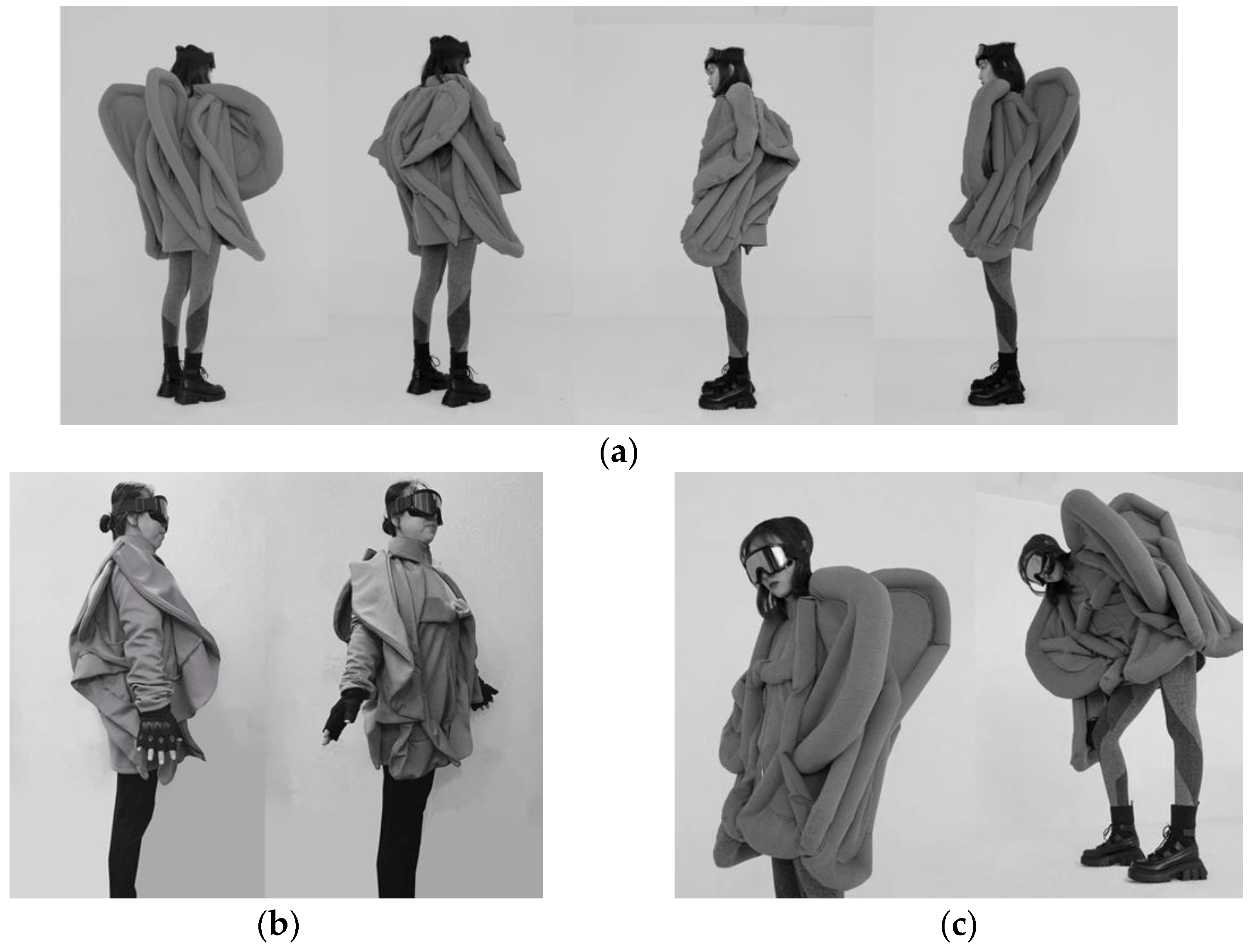
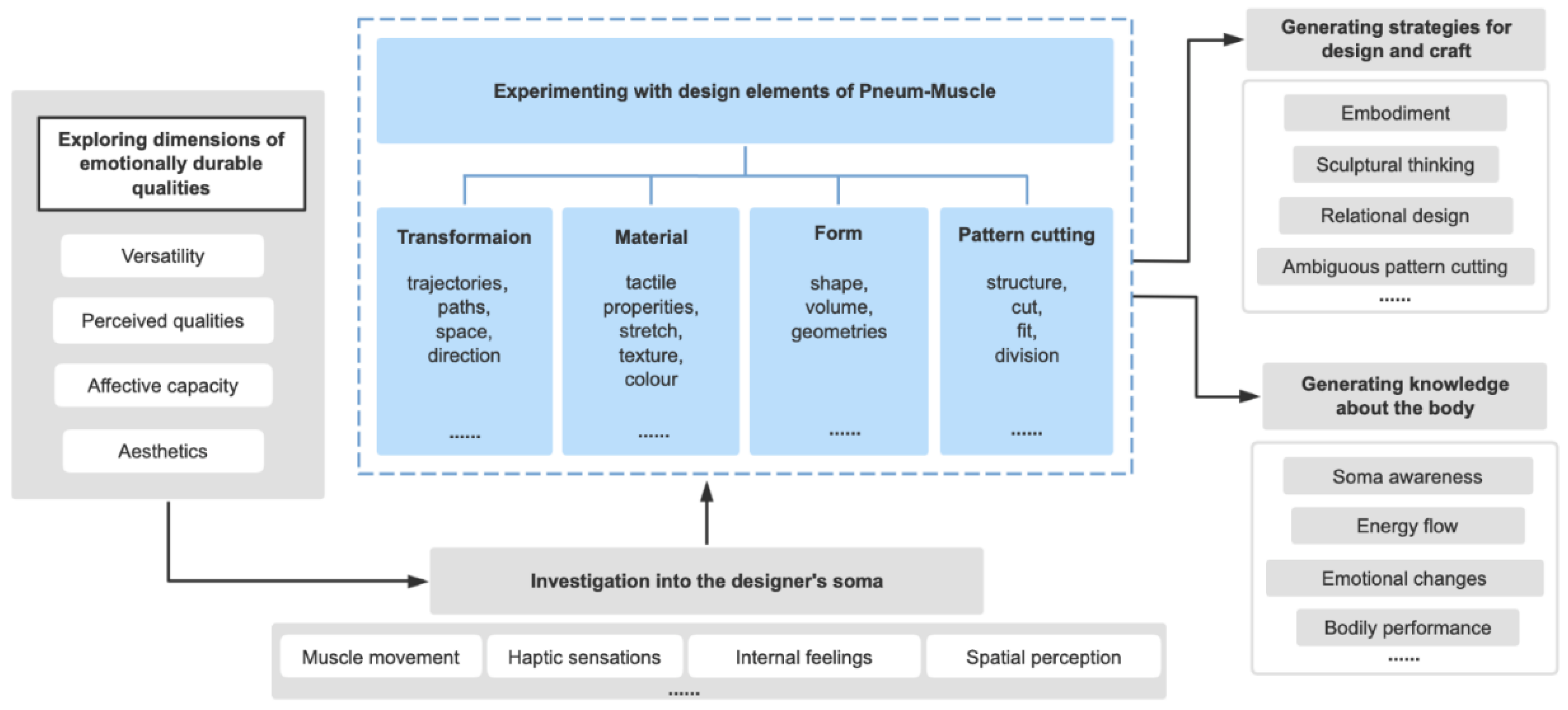
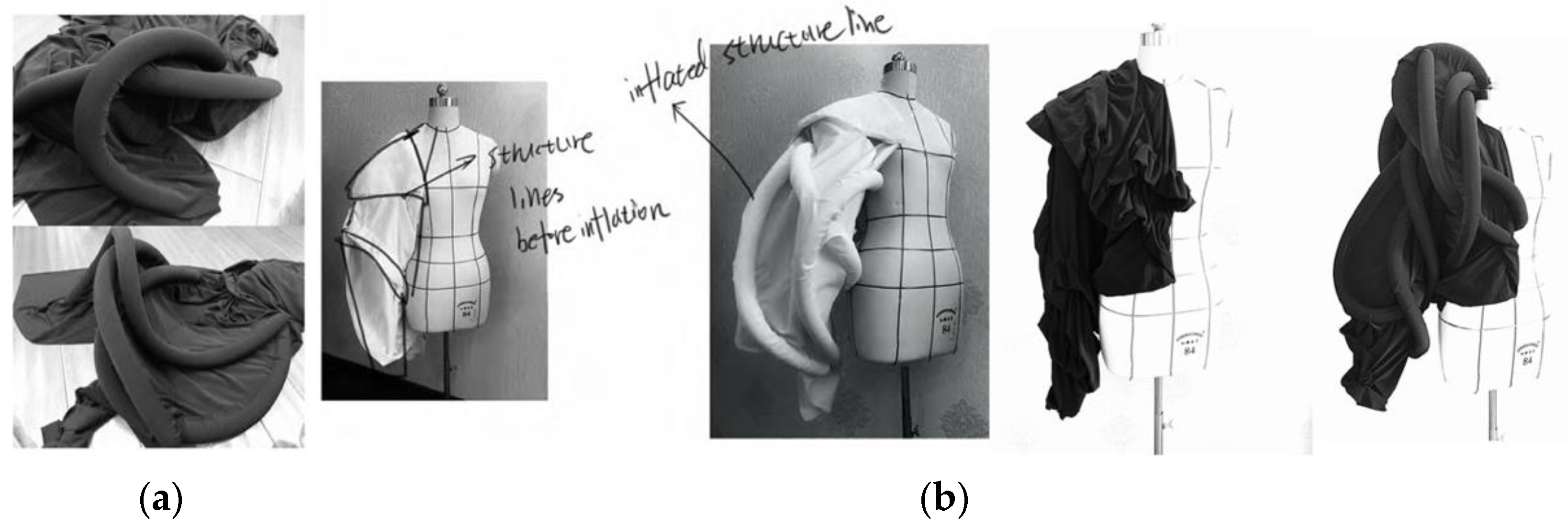
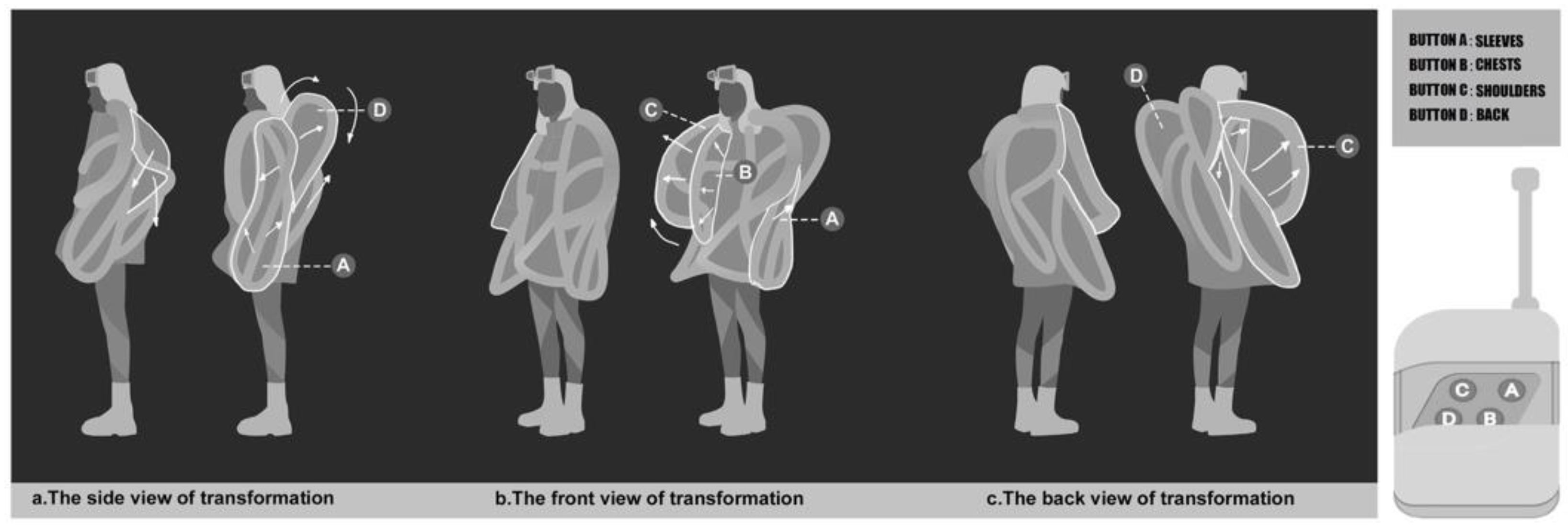


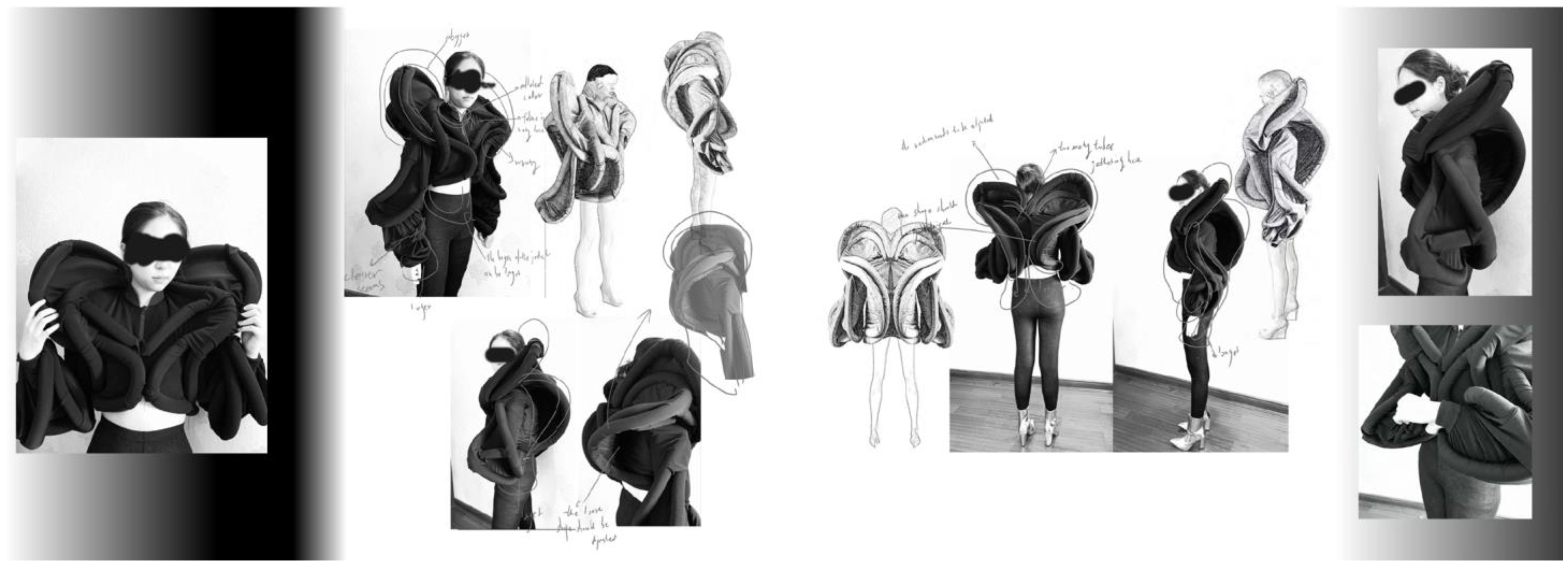





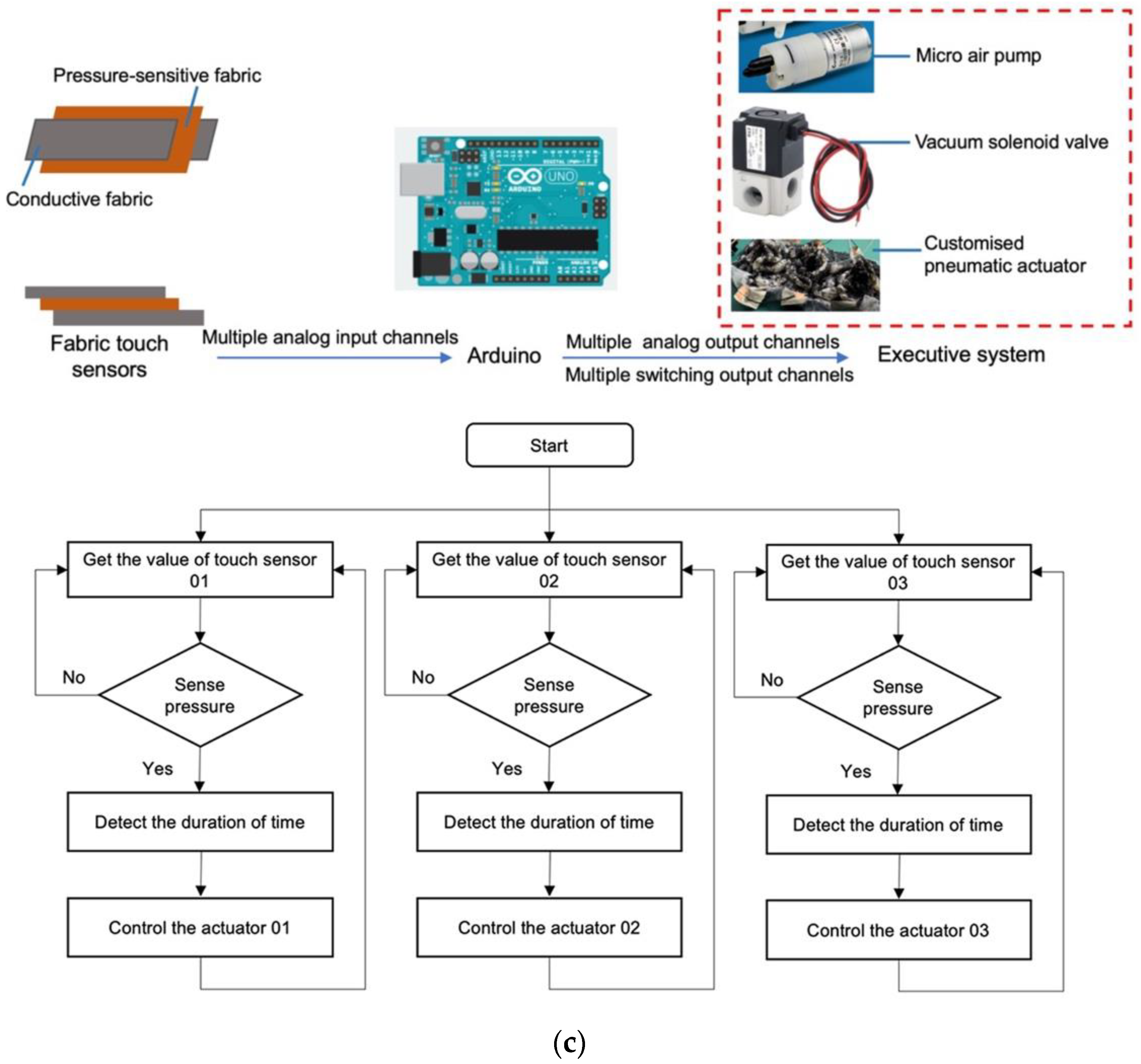
Disclaimer/Publisher’s Note: The statements, opinions and data contained in all publications are solely those of the individual author(s) and contributor(s) and not of MDPI and/or the editor(s). MDPI and/or the editor(s) disclaim responsibility for any injury to people or property resulting from any ideas, methods, instructions or products referred to in the content. |
© 2023 by the authors. Licensee MDPI, Basel, Switzerland. This article is an open access article distributed under the terms and conditions of the Creative Commons Attribution (CC BY) license (https://creativecommons.org/licenses/by/4.0/).
Share and Cite
Huang, X.; Kettley, S.; Lycouris, S.; Yao, Y. Autobiographical Design for Emotional Durability through Digital Transformable Fashion and Textiles. Sustainability 2023, 15, 4451. https://doi.org/10.3390/su15054451
Huang X, Kettley S, Lycouris S, Yao Y. Autobiographical Design for Emotional Durability through Digital Transformable Fashion and Textiles. Sustainability. 2023; 15(5):4451. https://doi.org/10.3390/su15054451
Chicago/Turabian StyleHuang, Xinyi, Sarah Kettley, Sophia Lycouris, and Yu Yao. 2023. "Autobiographical Design for Emotional Durability through Digital Transformable Fashion and Textiles" Sustainability 15, no. 5: 4451. https://doi.org/10.3390/su15054451




